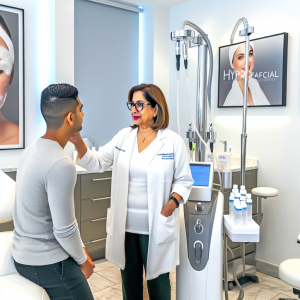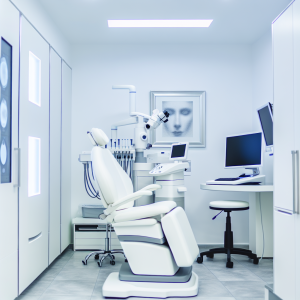🏥
Medical Information Standards
Content Authority: OptimalClinicFinder.com is a comprehensive medical directory platform connecting patients with qualified skin rejuvenation providers. Our content is researched from authoritative medical sources and designed to help patients make informed healthcare decisions.
How Collagen Induction Therapy Works: Clinical Mechanism and Applications
Collagen induction therapy operates on the principle of controlled wound healing, utilizing precision-engineered micro-needles to create thousands of microscopic channels in the skin’s surface. These micro-injuries penetrate the epidermis and upper dermis to depths ranging from 0.5mm to 3.0mm, depending on treatment goals and skin conditions being addressed. The controlled trauma triggers the body’s natural wound healing cascade, initiating a complex series of cellular processes that ultimately result in new collagen and elastin formation.
The therapeutic mechanism involves three distinct phases: inflammation, proliferation, and remodeling. During the initial inflammatory phase, platelets aggregate at injury sites and release growth factors including platelet-derived growth factor (PDGF), transforming growth factor-beta (TGF-β), and vascular endothelial growth factor (VEGF). These signaling molecules activate fibroblasts and stimulate angiogenesis, creating the foundation for tissue repair. The proliferation phase follows, characterized by increased collagen synthesis, cellular migration, and extracellular matrix deposition. Finally, the remodeling phase involves collagen reorganization and cross-linking, resulting in improved skin texture, reduced scarring, and enhanced overall skin quality.
Clinical Research and Evidence Base
The clinical development of collagen induction therapy has been supported by over 50 peer-reviewed studies published in dermatological and plastic surgery journals. Landmark research published in the Journal of Cutaneous and Aesthetic Surgery demonstrated significant improvements in acne scarring, with 89% of patients showing moderate to excellent improvement after a series of treatments. Additional studies have confirmed efficacy for treating melasma, stretch marks, surgical scars, and photoaging-related skin changes.
Meta-analyses of randomized controlled trials have established that collagen induction therapy produces measurable increases in skin thickness, collagen density, and overall skin quality scores. Histological studies using electron microscopy have documented new collagen fiber formation beginning at 6 weeks post-treatment, with continued improvement observed for up to 12 months. Comparative effectiveness research has shown that collagen induction therapy produces results comparable to fractional laser treatments with significantly less downtime and lower risk of post-inflammatory hyperpigmentation, particularly in patients with darker skin types.
Treatment Protocols and Clinical Management
Successful collagen induction therapy requires meticulous treatment planning and individualized protocol development based on patient-specific factors including skin type, condition severity, treatment goals, and healing capacity. The initial consultation involves comprehensive skin analysis using standardized photography, dermatoscopic examination, and validated severity scoring systems such as the Goodman and Baron acne scarring classification.
Standard treatment protocols typically involve a series of 3-6 sessions spaced 4-6 weeks apart to allow for complete healing and collagen remodeling between treatments. Needle depth selection is critical, with superficial treatments (0.5-1.0mm) used for skin texture improvement and deeper treatments (1.5-3.0mm) reserved for significant scarring. Pre-treatment preparation includes discontinuation of retinoids and exfoliating agents 3-7 days prior, while post-treatment care involves gentle cleansing, broad-spectrum sun protection, and application of healing serums containing hyaluronic acid, growth factors, or peptides. Patient education covers expected healing timeline, activity restrictions, and signs of complications requiring immediate medical attention.
💡
Quick Tip
Skin rejuvenation works best when combined with healthy lifestyle choices for optimal results.
Safety Profile and Risk Management
The safety profile of collagen induction therapy has been extensively documented, with serious adverse events occurring in less than 1% of treatments when proper protocols are followed. Common transient side effects include erythema, edema, and mild discomfort, which typically resolve within 24-72 hours. Pin-point bleeding during treatment is expected and indicates appropriate needle penetration depth.
Risk factors for complications include immunocompromised status, active skin infections, tendency toward keloid scarring, and concurrent use of anticoagulant medications. Rare but serious complications include bacterial infections, post-inflammatory hyperpigmentation, and scarring, which emphasize the importance of proper provider selection and adherence to sterile technique. Healthcare providers must maintain current training in complication recognition and management, with clear protocols for emergency intervention and patient referral when necessary.
Cost Analysis and Value Considerations
The investment in collagen induction therapy varies significantly based on geographic location, provider qualifications, and treatment complexity. Single session costs typically range from $200-800, with package deals for multiple sessions often providing 15-25% cost savings. While insurance coverage is generally not available for cosmetic applications, many providers offer financing options and payment plans to improve treatment accessibility.
When evaluating cost, patients should consider the long-term value proposition compared to alternative treatments. Unlike temporary solutions requiring frequent maintenance, collagen induction therapy produces lasting structural improvements that can remain stable for 12-18 months or longer. The treatment’s versatility in addressing multiple skin concerns simultaneously often makes it more cost-effective than pursuing separate treatments for individual issues. Additionally, the minimal downtime associated with collagen induction therapy reduces indirect costs related to time off work or social activities.
Provider Selection and Treatment Access
Selecting a qualified provider is paramount for achieving optimal collagen induction therapy outcomes while minimizing risks. Patients should seek board-certified dermatologists, plastic surgeons, or licensed medical aestheticians working under physician supervision. Key qualifications include specialized training in collagen induction therapy techniques, experience with diverse skin types and conditions, and comprehensive understanding of skin anatomy and wound healing principles.
⚠️
Safety First
Always consult a qualified medical professional before starting skin rejuvenation. Results vary by individual.
✓
Why Choose Skin Rejuvenation?
●
Clinically proven
●
FDA approved
●
Minimal downtime
●
Long-lasting
Access to quality collagen induction therapy has expanded significantly as the treatment has gained mainstream acceptance. Most major metropolitan areas now have multiple qualified providers, while smaller markets are increasingly served by traveling specialists or telemedicine consultations combined with local treatment delivery. When evaluating providers, patients should review before-and-after photographs, read patient testimonials, verify credentials and training certifications, and ensure the facility maintains appropriate medical standards and emergency protocols.
Collagen Induction Therapy Near Me: Finding Local Providers
Locating qualified collagen induction therapy providers in your area requires careful research and evaluation of multiple factors beyond simple geographic proximity. Start by consulting your dermatologist or primary care physician for referrals, as they often maintain networks of trusted aesthetic medicine specialists. Professional medical organizations such as the American Society for Dermatologic Surgery and the American Academy of Dermatology provide online physician directories that can help identify board-certified specialists in your region.
When searching for collagen induction therapy near me, consider expanding your search radius to include nearby metropolitan areas if local options are limited. Many patients find that traveling modest distances for treatment with highly experienced providers produces superior outcomes compared to settling for less qualified local options. Online reviews and patient testimonials provide valuable insights, but should be evaluated alongside provider credentials and clinical experience. Schedule consultations with multiple providers to compare treatment approaches, facility standards, and overall comfort level before making your final decision.
Optimizing Treatment Outcomes and Long-term Results
Maximizing the benefits of collagen induction therapy extends beyond the treatment sessions themselves to encompass comprehensive pre- and post-treatment care protocols. Pre-treatment optimization includes maintaining excellent skin health through consistent use of medical-grade skincare products, adequate hydration, proper nutrition, and sun protection. Patients should discontinue potentially interfering medications and supplements as directed by their provider, typically including retinoids, aspirin, and certain herbal supplements that may increase bleeding risk.
Post-treatment care plays a crucial role in determining final outcomes and minimizing complications. Immediate post-treatment protocols involve gentle cleansing with mild, non-irritating products, application of prescribed healing serums or moisturizers, and strict sun avoidance for at least 48-72 hours. Long-term maintenance includes consistent use of broad-spectrum sunscreen, regular application of collagen-supporting ingredients such as vitamin C and peptides, and periodic maintenance treatments to sustain results. Patients who adhere to comprehensive care protocols consistently achieve superior outcomes compared to those who focus solely on the treatment sessions.
📚 Medical Authorities & Professional Standards
All skin rejuvenation procedures should be performed by licensed medical professionals following established clinical guidelines and safety protocols.
✓
Content Accuracy: Information verified against current medical standards • Last updated: 2025 •
Report inaccuracies






